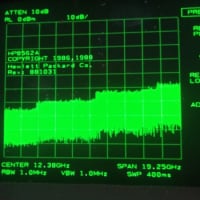Welcome to the FlexRadio Community! Please review the new Community Rules and other important new Community information on the Message Board.
Need the latest SmartSDR or 4O3A Genius Product Software?
SmartSDR v4.1.3 and the SmartSDR v4.1.3 Release Notes
SmartSDR v3.10.15 and the SmartSDR v3.10.15 Release Notes
The latest 4O3A Genius Product Software and Firmware
SmartSDR v4.1.3 and the SmartSDR v4.1.3 Release Notes
SmartSDR v3.10.15 and the SmartSDR v3.10.15 Release Notes
The latest 4O3A Genius Product Software and Firmware
If you are having a problem, please refer to the product documentation or check the Help Center for known solutions.
Need technical support from FlexRadio? It's as simple as Creating a HelpDesk ticket.
Need technical support from FlexRadio? It's as simple as Creating a HelpDesk ticket.
SWR and Receive

Dwayne_AB6A
Member ✭✭
I love the radio and multilink but running into some antenna issues... A G5RV and SWR appears to be as important for receive as it is for transmit... When slices are separated far enough, the receive slice that does not match my antenna tuner has significant signal degradation. Has anyone else observed this and any feedback on how to mitigate??
0
Answers
-
I guess your antenna needs to be more broadbanded then it is. Your listening to a portion of the band that your antenna can't work proplerly on.1
-
Makes perfect sense... I'm still learning and up until now thought that SWR/bandwidth really only affected transmit.0
-
No,,, try this,,it helps you see what is going on.
Zoom way out so you see the full band, look at the noise floor. You will see a spot were the floor is high and down the band it may be much lower. Manually tune your tuner and you can see the floor move up and down depending were your antenna is resenant2 -
Have a look at zs6bkw, optimized variant of g5rv that often doesn’t require a tuner. https://www.w5ddl.org/files/Zs6bkw_vs_G5rv_20100221b.pdf2
-
Thanks all! Im the primary user of my radio and my current antenna choices are limited due to my property/location. I see a vertical in my future.0
-
Pretty sure the ATU is out of the picture on the receiver? I spent a whole day measuring some of my radio's receiver input impedances with one of my VNA's and not too many radios are 50 ohms or even close, lots of variables, preamp on or off, attenuation just to name a few.
0 -
What are the primary bands do you use. I use 40m and 80m most the time. My city lot is small. I have a 50 foot tower. I am using a 40 and 80 meter dipole that is 63 feet over all end to end. The SWR hardly changes at all from the top of the band to bottom.0
-
All of your antenna system losses whether they be due to SWR, feedline loss, or a mismatch will effect both transmit and receive.0
-
I think Dwayne's question was regarding the ATU with the radio while receiving. As far as I know the ATU is not in play when receiving. I've done some mods with older radios that let me switch on the ATU for both xmit & receive and most of the time the signal was weaker because the ATU was matching the antenna system to get the lowest SWR to satisfy the transmitter. An easy test is to use an outboard tuner and I'll bet if after tuning for best SWR in transmit than if you tune for maximum receive signal the settings will not me the same on the tuner.0
-
Just to be clear - I am using an external ATU so radios ATU is in bypass for all bands. I have a Palstar HF-Auto.
The question is more around how big a difference a tuner plays for both transmit and receive... Not just transmit.
Since antenna tuning makes such a difference for receive, how should antennas be configured for optimal multi user configuration?
For each user, you can’t tell what band they are using or how the antenna is tuned irrespective of internal or external ATU.0 -
I have issues with height and space and am even considering a mag loop which now I believe would exacerbate my issues.0
-
Try a magnetic loop antenna. I use a no tune magnet loop with 30 dB preamp connected to the RXA port on my 6600. It is only 38" in diameter and is mounted on a 10 foot high post and works great on 160 - 30 meters. I bought mine several years ago from Pixel. I believe it is now sold by DX Engineering. While not cheap, it is compact and pulls out the really weak signals.0
-
On receive, engaging an ATU to lower SWR will not increase signal to noise ratio (SNR) and therefore signal intelligibility on the HF bands. Yes, the signal will appear “louder”, but so will the noise (remember that noise is signal too), and the net result is no change in SNR.
What can make a major difference on receive is the use of directional antennas, which reduce noise from directions other than the desired signals, and therefore may increase the SNR. That’s how specialized “receive” antennas like beverages work. They have negative gain in all directions, but reject noise from undesired directions, and therefore can increase SNR. Using diversity receive can make a big difference too.
Howard
0
Leave a Comment
Categories
- All Categories
- 371 Community Topics
- 2.1K New Ideas
- 629 The Flea Market
- 8.2K Software
- 94 SmartSDR+
- 6.4K SmartSDR for Windows
- 182 SmartSDR for Maestro and M models
- 424 SmartSDR for Mac
- 270 SmartSDR for iOS
- 255 SmartSDR CAT
- 190 DAX
- 381 SmartSDR API
- 9.3K Radios and Accessories
- 36 Aurora
- 248 FLEX-8000 Signature Series
- 7.2K FLEX-6000 Signature Series
- 937 Maestro
- 54 FlexControl
- 863 FLEX Series (Legacy) Radios
- 917 Genius Products
- 460 Power Genius XL Amplifier
- 334 Tuner Genius XL
- 123 Antenna Genius
- 294 Shack Infrastructure
- 206 Networking
- 452 Remote Operation (SmartLink)
- 144 Contesting
- 782 Peripherals & Station Integration
- 139 Amateur Radio Interests
- 996 Third-Party Software


